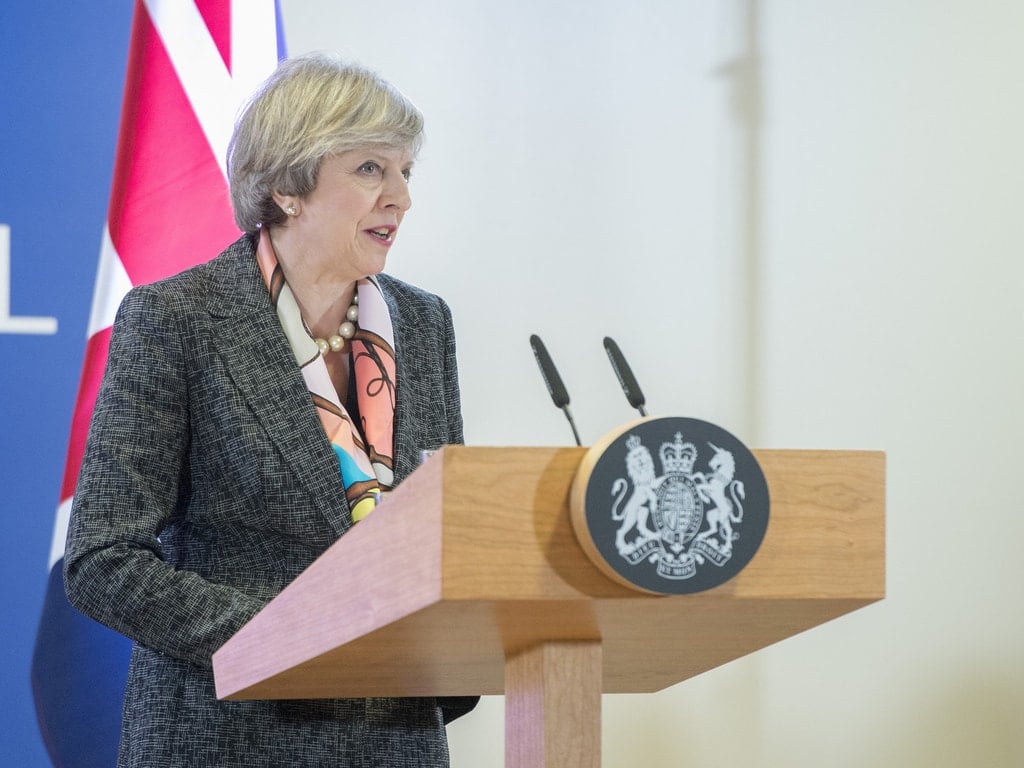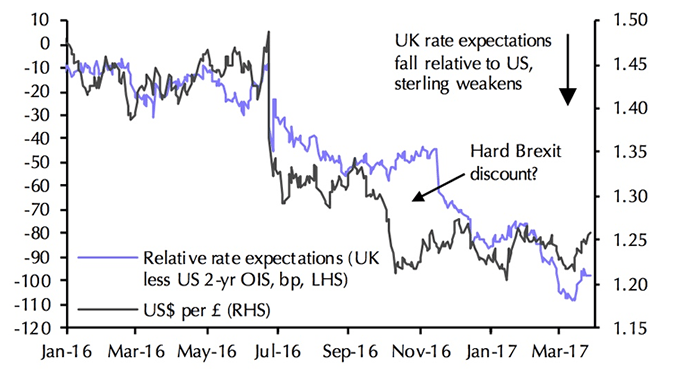Pound Sterling Forecast to go Higher Against Euro + Dollar Following Article 50 Trigger say Capital Economics

Pictured Above: Prime Minister Theresa May gave a press conference at the European Council meeting in Brussels. Credit: Jay Allen, Copyright: Crown Copyright
The British Pound was seen recovering some of its earlier losses against its major competitors ahead of the official triggering of Article 50 of the Lisbon Treaty.
The UK will today start its march towards an exit of the European Union and Pound Sterling Live are presenting the contrasting views of analysts as to how the Pound might react over coming days.
Overnight Theresa May signed the latter that will be delivered to EU Council President Donald Tusk by the UK's ambassador at 12:30 B.S.T.
The opportunity for volatility in the Pound increases from this point. At the time of writing the Pound to Euro exchange rate trades at 1.1546, up 0.26% on the day while the Pound to Dollar exchange rate trades at 1.2421, down 0.24% on the day.
Sterling had gone as low as 1.1445 against the Euro and 1.2375 against the Dollar as nerves dominated ahead of official start of the UK's exit from the European Union.
"Article 50 happened with more of a whimper than a bang. Although the pound initially rallied it has since backed off its highs as the market gets to grip with Theresa May’s letter to Donald Tusk and the EU’s response. Essentially both sides were polite to each other, which helped to keep volatility supressed and price action fairly muted," says analyst Kathleen Brooks at City Index.
This does not mean to say the Pound will be without direction over coming days, and we could well see the recent uptrend extend.
British Pound: Downside Risks Limited
Pound Sterling has risen some 5% from its October 2016 lows as the initial readjustment phase following the initial shock of the June referendum outcome is fully absorbed.
Since October the Pound has traded familiar levels against the majority of its G10 peers with another period of strength being seen over the course of the final half of March.
The move has come primarily against the US Dollar, with GBP/USD climbing to its highest level since the end of February at 1.2616.
“Sterling has also made modest gains against the Euro, with the result that the Sterling trade-weighted index has risen by almost 2% to stand some 5% above last October’s post-referendum low,” says Jonathan Loynes, an economist with Capital Economics.
Loynes is of the opinion that the triggering of Article 50 could introduce some downside risks.
After all, the below chart shows that, while some of the Pound’s recent rise against the US Dollar has reflected a shift in relative interest rate expectations, an apparent “Hard-Brexit discount” previously depressing the Pound appears to have faded too.
Above: The Pound to Dollar exchange rate contrasted to relative interest rate expectations between US and UK. Source: Thomson Reuters and Capital Economics
Loynes says Article 50 could reintroduce that discount by making Brexit a reality and perhaps triggering a surge in media and market speculation over the final outcome of the negotiations.
And for a political currency like Sterling, perception is crucial.
Nevertheless, Capital Economics are sceptical that such an effect will materialise.
Why the British Pound Could Get a Boost Over Coming Days
As we and others have noted on many an occasion, while the triggering of Article 50 is a major step along the road to Brexit, it will hardly come as a shock.
Any suggestions that the UK might not actually leave the EU disappeared months ago.
And the 52% of referendum voters who wanted Brexit will presumably be pleased to see the process finally commence.
“Indeed, it’s perhaps more likely that the formal commencement of Brexit will give the Pound another boost,” says Loynes as markets are furnished with yet more clarity on the outlook facing the UK’s relationship with Europe.
What the Pound and businesses up and down the country really wants is clarity on the way forward.
This view echoes that of analysts at Barclays who believe there is indeed the prospect for Sterling to rise in the wake of Article 50 being triggered.
“If the UK government’s letter announcing Article 50 contains conciliatory language, and this is echoed in the response from the EU, then hard Brexit worries could certainly dissipate somewhat further,” says Loynes.
If an easing of Brexit worries does raise the Pound further, this will no doubt be seen by many as a positive development.
Indeed, analyst Simon Penn at UBS believes that because the UK is fundamentally a nation of importers the UK economy needs a stronger Pound to shore up consumer sentiment.
Loynes takes umbrage with this view noting that the rise in the British Pound wouldn’t be unambiguously good news:
“After all, sterling’s post-referendum depreciation has boosted exporters’ order books and helped to facilitate some long-desired rebalancing of the economy.”
If anything the analyst believes a stronger Pound could prove an awkward obstacle to the process of normalising UK monetary policy which some MPC members are keen to commence in order to ease the distortions caused by very low interest rates and provide new ammunition with which to respond to the next economic downturn.
Recall that the Pound is tracking interest rate expectations as per the above image? Therefore, what this argument boils down to is how upcoming Brexit moves will impact on expectations on the Bank of England’s next moves.
For now, Capital Economics feel none of this will trouble the MPC too much.
After all, the Pound could soon start to drop back against the US dollar at least if, as we expect, market expectations for US interest rates start to rise again.
“And even if it doesn’t, the MPC will instinctively prefer a strongish exchange rate to a weakish one,” says Loynes. “But a further significant rise in the Pound could certainly present the Committee with some difficult choices.”
Bank of America: April Could be a Good Month for Sterling
Meanwhile strategists at Bank of America Merrill Lynch Global Research have updated clients on their views pertaining to Sterling's outlook.
"Our bias remains for renewed GBP weakness at the higher end of the 1Q17 technical range, but we are cognisant of the ongoing positioning unwind, positive April seasonal factors which has seen GBP rally in every April over the past twelve years and unconfirmed technical base," says a note from Kamal Sharma, FX Strategist at BofA Merrill Lynch.
Therefore, those watching Sterling could do well to allow it to advance a little further as the Article 50 triggering, "does not itself provide the catalyst for renewed GBP weakness".
But, upcoming Brexit negotiations could undo the currency.
"Market complacency on the ability of the UK and EU to strike a comprehensive deal within the timeline with the least political/economic disruption is the motivation for a move back towards the bottom end and test of the trading range," says Sharma.
So while a move towards the lows of the range can be expected we note that no crash to fresh multi-year lows are envisaged.






